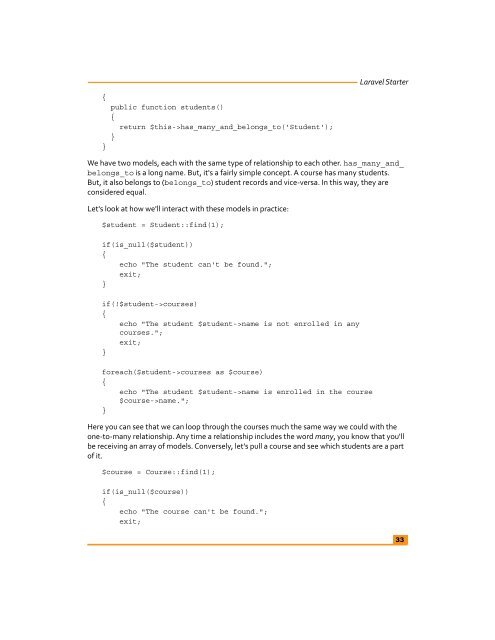Laravel Starter - PHP User Group (Myanmar)
Laravel Starter - PHP User Group (Myanmar)
Laravel Starter - PHP User Group (Myanmar)
Create successful ePaper yourself
Turn your PDF publications into a flip-book with our unique Google optimized e-Paper software.
<strong>Laravel</strong> <strong>Starter</strong><br />
{<br />
}<br />
public function students()<br />
{<br />
return $this->has_many_and_belongs_to('Student');<br />
}<br />
We have two models, each with the same type of relationship to each other. has_many_and_<br />
belongs_to is a long name. But, it's a fairly simple concept. A course has many students.<br />
But, it also belongs to (belongs_to) student records and vice-versa. In this way, they are<br />
considered equal.<br />
Let's look at how we'll interact with these models in practice:<br />
$student = Student::find(1);<br />
if(is_null($student))<br />
{<br />
echo "The student can't be found.";<br />
exit;<br />
}<br />
if(!$student->courses)<br />
{<br />
echo "The student $student->name is not enrolled in any<br />
courses.";<br />
exit;<br />
}<br />
foreach($student->courses as $course)<br />
{<br />
echo "The student $student->name is enrolled in the course<br />
$course->name.";<br />
}<br />
Here you can see that we can loop through the courses much the same way we could with the<br />
one-to-many relationship. Any time a relationship includes the word many, you know that you'll<br />
be receiving an array of models. Conversely, let's pull a course and see which students are a part<br />
of it.<br />
$course = Course::find(1);<br />
if(is_null($course))<br />
{<br />
echo "The course can't be found.";<br />
exit;<br />
33




